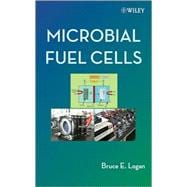
Bruce E. Logan, PHD, is the Stan and Flora Kappe Professor of EnvironmentalEngineering at Penn State University, and Director of Penn State's Hydrogen Energy (H2E) Center and the Engineering Environmental Institute. Dr. Logan's areas of expertise include bioenergy (microbial fuel cells and biohydrogen production),bacterial adhesion, colloid transport, and bioremediation. He is the author or coauthor of over 200 refereed publications and books on environmental transport processes, microbial fuel cells, and perchlorate reduction.
| Preface | p. xi |
| Introduction | p. 1 |
| Energy needs | p. 1 |
| Energy and the challenge of global climate change | p. 2 |
| Bioelectricity generation using a microbial fuel cell-the process of electrogenesis | p. 4 |
| MFCs and energy sustainability of the water infrastructure | p. 6 |
| MFC technologies for wastewater treatment | p. 7 |
| Renewable energy generation using MFCs | p. 9 |
| Other applications of MFC technologies | p. 11 |
| Exoelectrogens | p. 12 |
| Introduction | p. 12 |
| Mechanisms of electron transfer | p. 13 |
| MFC studies using known exoelectrogenic strains | p. 18 |
| Community analysis | p. 22 |
| MFCs as tools for studying exoelectrogens | p. 27 |
| Voltage Generation | p. 29 |
| Voltage and current | p. 29 |
| Maximum voltages based on thermodynamic relationships | p. 30 |
| Anode potentials and enzyme potentials | p. 36 |
| Role of communities versus enzymes in setting anode potentials | p. 40 |
| Voltage generation by fermentative bacteria? | p. 41 |
| Power Generation | p. 44 |
| Calculating power | p. 44 |
| Coulombic and energy efficiency | p. 48 |
| Polarization and power density curves | p. 50 |
| Measuring internal resistance | p. 54 |
| Chemical and electrochemical analysis of reactors | p. 57 |
| Materials | p. 61 |
| Finding low-cost, highly efficient materials | p. 61 |
| Anode materials | p. 62 |
| Membranes and separators (and chemical transport through them) | p. 68 |
| Cathode materials | p. 76 |
| Long-term stability of different materials | p. 83 |
| Architecture | p. 85 |
| General requirements | p. 85 |
| Air-cathode MFCs | p. 86 |
| Aqueous cathodes using dissolved oxygen | p. 95 |
| Two-chamber reactors with soluble catholytes or poised potentials | p. 97 |
| Tubular packed bed reactors | p. 102 |
| Stacked MFCs | p. 104 |
| Metal catholytes | p. 105 |
| Biohydrogen MFCs | p. 108 |
| Towards a scalable MFC architecture | p. 110 |
| Kinetics and Mass Transfer | p. 111 |
| Kinetic- or mass transfer-based models? | p. 111 |
| Boundaries on rate constants and bacterial characteristics | p. 112 |
| Maximum power from a monolayer of bacteria | p. 116 |
| Maximum rate of mass transfer to a biofilm | p. 118 |
| Mass transfer per reactor volume | p. 122 |
| MECS for Hydrogen Production | p. 125 |
| Principle of operation | p. 125 |
| MEC systems | p. 127 |
| Hydrogen yield | p. 131 |
| Hydrogen recovery | p. 132 |
| Energy recovery | p. 134 |
| Hydrogen losses | p. 142 |
| Differences between the MEC and MFC systems | p. 145 |
| MFCs for Wastewater Treatment | p. 146 |
| Process trains for WWTPs | p. 146 |
| Replacement of the biological treatment reactor with an MFC | p. 149 |
| Energy balances for WWTPs | p. 154 |
| Implications for reduced sludge generation | p. 157 |
| Nutrient removal | p. 158 |
| Electrogenesis versus methanogenesis | p. 159 |
| Other MFC Technologies | p. 162 |
| Different applications for MFC-based technologies | p. 162 |
| Sediment MFCs | p. 162 |
| Enhanced sediment MFCs | p. 166 |
| Bioremediation using MFC technologies | p. 168 |
| Fun! | p. 171 |
| MFCs for new scientists and inventors | p. 171 |
| Choosing your inoculum and media | p. 174 |
| MFC materials: electrodes and membranes | p. 175 |
| MFC architectures that are easy to build | p. 176 |
| MEC reactors | p. 180 |
| Operation and assessment of MFCs | p. 181 |
| Outlook | p. 182 |
| MFCs yesterday and today | p. 182 |
| Challenges for bringing MFCs to commercialization | p. 183 |
| Accomplishments and outlook | p. 184 |
| Notation | p. 186 |
| References | p. 189 |
| Index | p. 199 |
| Table of Contents provided by Ingram. All Rights Reserved. |
The New copy of this book will include any supplemental materials advertised. Please check the title of the book to determine if it should include any access cards, study guides, lab manuals, CDs, etc.
The Used, Rental and eBook copies of this book are not guaranteed to include any supplemental materials. Typically, only the book itself is included. This is true even if the title states it includes any access cards, study guides, lab manuals, CDs, etc.